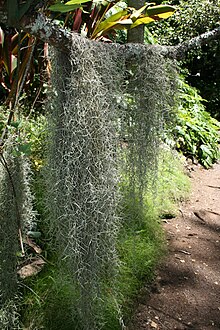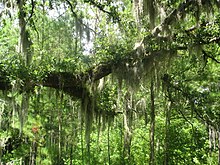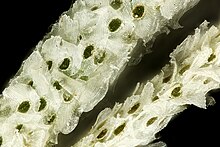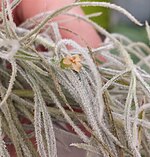Spanish moss
| Spanish moss | |
|---|---|

| |
| Scientific classification | |
| Kingdom: | Plantae |
| Clade: | Tracheophytes |
| Clade: | Angiosperms |
| Clade: | Monocots |
| Clade: | Commelinids |
| Order: | Poales |
| Family: | Bromeliaceae |
| Genus: | Tillandsia |
| Subgenus: | Tillandsiasubg.Diaphoranthema |
| Species: | T. usneoides
|
| Binomial name | |
| Tillandsia usneoides | |
| Synonyms[3] | |
| |
Spanish moss(Tillandsia usneoides) is anepiphyticflowering plantthat often grows upon large trees in tropical and subtropical climates. It is native to much ofMexico,Bermuda,theBahamas,Central America,South America,theSouthern United States,andWest Indies.It has been naturalized inQueensland(Australia). It is known as "grandpa's beard" inFrench Polynesia.[3]
Most known in theUnited States,it commonly is found on the southern live oak (Quercus virginiana) and bald cypress (Taxodium distichum) in the lowlands, swamps, and marshes of the mid-Atlantic and Southeastern states, from the coast of southeasternVirginiatoFloridaand west to southernArkansasandTexas.[4][5]While it superficially resembles its namesake, thelichenUsnea,it is neither a lichen nor amoss,and it is not native toSpain.
Description[edit]

Spanish moss consists of one or more slender stems, bearing alternate thin, curved or curly, and heavily scaledleaves2–6 cm (0.8–2.4 inches) long and 1 mm (0.04 inches) broad, that grow vegetatively in a chain-like fashion (pendant), forming hanging structures of up to 6 m (20 feet).[6]
The plant has noroots.[6][7]Its flowers are yellow-green and small, with spreading petals. Thescapeis partly hidden within the leaf sheath.[4]Spanish moss propagates both by seed andvegetativelyby fragments that are carried on the wind and stick to tree limbs or that are carried to other locations by birds as nesting material.[citation needed]
Taxonomy[edit]
Spanish moss is in the familyBromeliaceae(the bromeliads). Formerly, it was placed in the generaAnoplophytum,Caraguata,andRenealmia.[8]Thespecific nameof the plant,usneoides,means "resemblingUsnea",a lichen.[9]
Habitat and distribution[edit]
Spanish moss' primary range is in the Southeastern United States (includingPuerto Ricoand theU.S. Virgin Islands) toArgentina,where the climate is warm enough and a relatively high averagehumidityoccurs.[citation needed]In North America, it occurs in a broad band following theGulf of Mexicoand the southern Atlantic coast.[5]The northern limit of its natural range isNorthampton County,Virginia,[10]with colonial-era reports of it in southernMaryland,[11][page needed][12][13][14]where no populations are now known to exist.[14]
It has been introduced to locations around the world with similar conditions, includingHawaii,where it first established itself in the nineteenth century.[15]
Ecology[edit]

Spanish moss is not parasitic: it is anepiphytethat absorbs nutrients and water through its own leaves from the air and rain falling upon it. While its presence rarely kills the trees on which it grows, it occasionally becomes so thick that, by shading the leaves of the tree, it slows the growth rate of the tree.[6]It can use the water-conserving strategy ofcrassulacean acid metabolismfor photosynthesis.[16][17]
In the southern U.S., the plant seems to show preferences for southern live oak (Quercus virginiana) and bald cypress (Taxodium distichum) because of their high rates of foliar mineral leaching (calcium,magnesium,potassium,andphosphorus) that provides an abundant supply of nutrients to the epiphytic plant.[18]It can also colonize other tree species such as sweetgum (Liquidambar styraciflua), crepe-myrtles (Lagerstroemiaspp.), other oaks, and evenpines.[citation needed]It also grows more uncommonly on artificial structures such as fencing and telephone lines.[4]
Spanish moss shelters a number of creatures, includingrat snakesand three species ofbats.One species ofjumping spider,Pelegrina tillandsiae,has been found only on Spanish moss.[19]Although widely presumed to infest Spanish moss, in one study of the ecology of the plant,chiggerswere not present among thousands of other arthropods identified on the plant.[20]
Spanish moss is sensitive to airborne contaminants. It does not grow in areas where smoke is common, such as near chimneys. It has receded from urban areas due to increasing air pollution.[6]
Culture and folklore[edit]

Spanish moss is often associated withSouthern Gothicimagery andDeep Southculture, due to its propensity for growing in subtropical humid southern locales such asAlabama,Southern Arkansas,Florida,Georgia,Louisiana,Mississippi,North Carolina,South Carolina,eastandsouthTexas, and extreme southern Virginia.
One anecdote about the origin of Spanish moss is called "the Meanest Man Who Ever Lived", in which the man's white hair grew very long and got caught on trees.[21]
Spanish moss wasintroducedto Hawaii in the nineteenth century. It became a popularornamentalandleiplant.[15]In Hawaii, it was named "ʻumiʻumi-o-Dole" after the beard ofSanford B. Dole,the first president of theProvisional Government of Hawaii.It is also known ashinahina,( "silvery" ) borrowing the name of the native heliotrope used in lei until shoreline development made access difficult. It has become a substitute for the nativehinahinain lei used for pageantry. In the early 21st century the plant was heavily marketed as "Pele's hair"/" lauoho-o-Pele ", which actually refers to a type of filamentousvolcanic glass.
Human uses[edit]



Spanish moss has been used for various purposes, includingbuilding insulation,mulch, packing material, mattress stuffing, and fiber. In the early 1900s it was used commercially in the padding of car seats.[22]More than 10,000 tons of processed Spanish moss was produced in 1939.[23]Today, it is collected in smaller quantities for use in arts and crafts, as bedding for flower gardens, and as an ingredient inbousillage,a traditional wall covering material. In some parts of Latin America and Louisiana, it is used innativity scenes.
In the desert regions of southwestern United States, dried Spanish moss is sometimes used in the manufacture ofevaporative coolers,colloquially known as "swamp coolers" (and in some areas as "desert coolers" ), which are used to cool homes and offices much less expensively than air conditioners. The cooling technology uses a pump that squirts water onto a pad made of Spanish moss plants; a fan then pulls air through the pad, and into the building. Evaporation of the water on the pads serves to reduce air temperature, cooling the building.[24]
Varieties and cultivars[edit]
- Tillandsia'Maurice's Robusta'[25]
- Tillandsia'Munro's Filiformis' – a naturalvarietywith very fine, green leaves that is native toParaguayand that is also known in the United States by thetrade designationsTillandsia usneoidesEl FinitoandSilver Ghost,it conforms to the description of the now-defunct varietyTillandsia usneoidesvar.filiformis(André)Mez[26]
- Tillandsia'Odin's Genuina': a natural variety with brown rather than green or yellow flowerpetalsthat is native toGuatemalaandMexico[27]
- Tillandsia'Spanish Gold'[28]
- Tillandsia'Tight and Curly'[29]
Hybrids[edit]
- Tillandsia'Nezley' (Tillandsia usneoides×mallemontii)[30]
- Tillandsia'Kimberly' (Tillandsia usneoides×recurvata)[31]
- Tillandsia'Old Man's Gold' (Tillandsia crocata×usneoides)[32]
See also[edit]
- Lace lichen,an organism of similar habit and appearance
References[edit]
- ^Treviño Zevallos, I. (2019)."Tillandsia usneoides".IUCN Red List of Threatened Species.2019:e.T131368905A131369229.doi:10.2305/IUCN.UK.2019-3.RLTS.T131368905A131369229.en.Retrieved16 October2022.
- ^"Tillandsia usneoides".Germplasm Resources Information Network.Agricultural Research Service,United States Department of Agriculture.Retrieved2009-12-08.
- ^abKew World Checklist of Selected Plant Families,Tillandsia usneoides
- ^abcLuther, Harry E.; Brown, Gregory K. (2000)."Tillandsia usneoides".In Flora of North America Editorial Committee (ed.).Flora of North America North of Mexico (FNA).Vol. 22. New York and Oxford: Oxford University Press – via eFloras.org,Missouri Botanical Garden,St. Louis, MO &Harvard University Herbaria,Cambridge, MA.
- ^ab"Tillandsia usneoides".County-level distribution map from the North American Plant Atlas (NAPA).Biota of North America Program (BONAP). 2014.
- ^abcd"Tillandsia usneoides".Floridata Plant Encyclopedia.
- ^"Sustainability-Spanish Moss".Institute of Food and Agricultural Sciences(IFAS), UF.2020-05-06.Retrieved2021-10-28.
- ^"Tillandsia".Germplasm Resources Information Network.Agricultural Research Service,United States Department of Agriculture.
- ^Damrosch, B.; Neal, B. (2003).Gardener's Latin: A Lexicon.Chapel Hill, N.C:Algonquin Books.p. 129.ISBN978-1-56512-743-2.OCLC856021571.Retrieved20 April2019.
- ^Times-Dispatch, REX SPRINGSTON Richmond."Virginia scientists search for northernmost realm of Spanish moss".Richmond Times-Dispatch.Retrieved2017-10-26.
- ^Ray, John(1688)."Historiæ Plantarum Tomus Secondus: cum Duplici Indice; Generali Altero Nominum & Synonymorum præcipuorum; Altero Affectuum & Remediorum: Accessit Nomenclator Botanicus Anglo-Latinus".Translated by Raii, Joannis.London.
- ^"Plants profile for Tillandsia usneoides".USDA.
- ^"Rare, Threatened, and Endangered Plants of Maryland"(PDF).
- ^abBrown, M.L.; R.G. Brown (1984).Herbaceous plants of Maryland.Baltimore: Port City Press, Inc.
- ^ab"Nā Lei o Hawai'i – Types of Lei".Archived fromthe originalon 2013-01-03.
- ^Kluge, M; Lange, O L; Eichmann, M V; Schmid, R (1973). "CAM in Tillandsia usneoides: Studies on the pathway of carbon and the dependency of CO2-exchange on light intensity, temperature and water content of the plant (in German)".Planta.112(4): 357–72.doi:10.1007/BF00390308.PMID24468815.
- ^Haslam, Richard; Borland, Anne; Maxwell, Kate; Griffiths, Howard (2003). "Physiological responses of the CAM epiphyte Tillandsia usneoides L. (Bromeliaceae) to variations in light and water supply".Journal of Plant Physiology.160(6): 627–34.doi:10.1078/0176-1617-00970.PMID12872484.
- ^Schlesinger, William H.; Marks, P. L. (1977). "Mineral Cycling and the Niche of Spanish Moss, Tillandsia usneoides L.".American Journal of Botany.64(10): 1254–1262.doi:10.2307/2442489.JSTOR2442489.
- ^Wildlife, State of Texas, Parks and."Flora Fact:| Spanish Moss Serves as Nature's Draperies".tpwmagazine.Retrieved2017-10-26.
{{cite web}}:CS1 maint: multiple names: authors list (link) - ^Whitaker Jr., J; Ruckdeschel, C. (2010). "Spanish Moss, the Unfinished Chigger Story".Southeastern Naturalist.9(1): 85–94.doi:10.1656/058.009.0107.S2CID86228838.
- ^Friedman, Amy; Johnson, Meredith (May 28, 2017)."The Meanest Man Who Ever Lived (An American Folktale)".Uexpress.RetrievedMay 31,2017.
- ^"Hair From Trees....Spanish-moss is new upholstering material".Popular Science.June 1937.
- ^"Adams, Dennis. Spanish Moss: Its Nature, History and Uses. Beaufort County Library, SC".Archived fromthe originalon 2017-02-01.Retrieved2009-06-20.
- ^Gutenberg, Arthur William (1955). The Economics of the Evaporative Cooler Industry in the Southwestern United States. Stanford University Graduate School of Business. p. 167.
- ^Bromeliad Cultivar Registry: Tillandsia 'Maurice's Robusta'
- ^Bromeliad Cultivar Registry: Tillandsia 'Munro's Filiformis'
- ^Bromeliad Cultivar Registry: Tillandsia 'Odin's Genuina'
- ^Bromeliad Cultivar Registry: Tillandsia 'Spanish Gold'
- ^Bromeliad Cultivar Registry: Tillandsia 'Tight and Curly'
- ^Bromeliad Cultivar Registry: Tillandsia 'Nezley'
- ^Bromeliad Cultivar Registry: Tillandsia 'Kimberly'
- ^Bromeliad Cultivar Registry: Tillandsia 'Old Man's Gold'
- Mabberley, D.J. 1987.The Plant Book. A Portable Dictionary of the Higher Plants.Cambridge University Press, Cambridge.ISBN0-521-34060-8.

